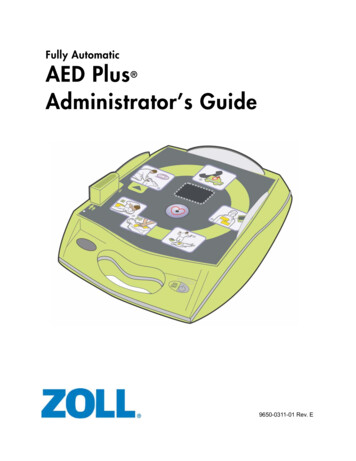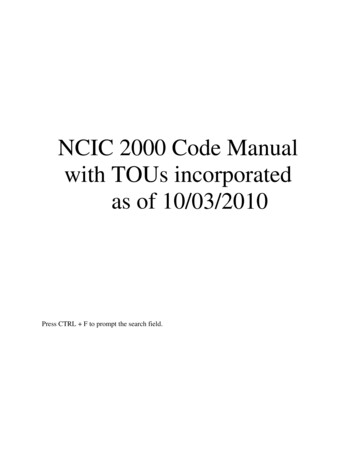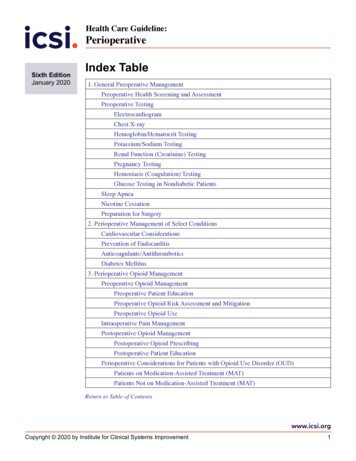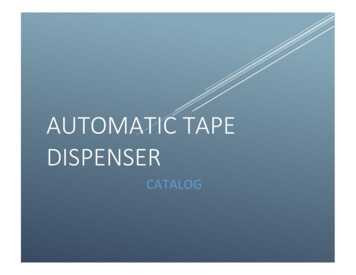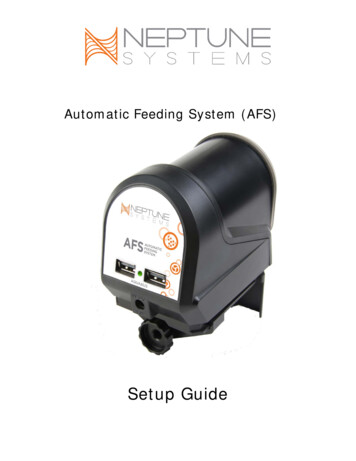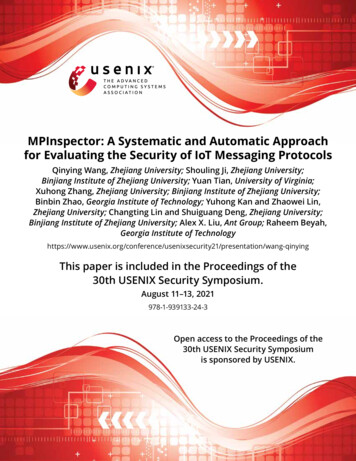
Transcription
MPInspector: A Systematic and Automatic Approachfor Evaluating the Security of IoT Messaging ProtocolsQinying Wang, Zhejiang University; Shouling Ji, Zhejiang University;Binjiang Institute of Zhejiang University; Yuan Tian, University of Virginia;Xuhong Zhang, Zhejiang University; Binjiang Institute of Zhejiang University;Binbin Zhao, Georgia Institute of Technology; Yuhong Kan and Zhaowei Lin,Zhejiang University; Changting Lin and Shuiguang Deng, Zhejiang University;Binjiang Institute of Zhejiang University; Alex X. Liu, Ant Group; Raheem Beyah,Georgia Institute of security21/presentation/wang-qinyingThis paper is included in the Proceedings of the30th USENIX Security Symposium.August 11–13, 2021978-1-939133-24-3Open access to the Proceedings of the30th USENIX Security Symposiumis sponsored by USENIX.
MPInspector: A Systematic and Automatic Approachfor Evaluating the Security of IoT Messaging ProtocolsQinying Wang† , Shouling Ji†, ¶ , Yuan Tian , Xuhong Zhang†, ¶ , Binbin Zhao§ , Yuhong Kan† , ZhaoweiLin† , Changting Lin†, ¶ , Shuiguang Deng†, ¶ , Alex X. Liu ‡ , and Raheem Beyah§† Zhejiang University, ¶ Binjiang Institute of Zhejiang University, University of Virginia, § Georgia Institute of Technology, ‡ Ant GroupE-mails: {wangqinying, sji}@zju.edu.cn, yuant@virginia.edu, zhangxuhong@zju.edu.cn, binbin.zhao@gatech.edu, {kan yuhong,leon.linzw}@zju.edu.cn, linchangting@gmail.com, dengsg@zju.edu.cn, alexliu@antgroup.com, rbeyah@gatech.edu.AbstractFacilitated by messaging protocols (MP), many home devicesare connected to the Internet, bringing convenience and accessibility to customers. However, most deployed MPs onIoT platforms are fragmented, which are not implementedcarefully to support secure communication. To the best ofour knowledge, there is no systematic solution to performautomatic security checks on MP implementations yet.To bridge the gap, we present MPInspector, the first automatic and systematic solution for vetting the security ofMP implementations. MPInspector combines model learning with formal analysis and operates in three stages: (a)using parameter semantics extraction and interaction logicextraction to automatically infer the state machine of an MPimplementation, (b) generating security properties based onmeta properties and the state machine, and (c) applying automatic property based formal verification to identify propertyviolations. We evaluate MPInspector on three popular MPs,including MQTT, CoAP and AMQP, implemented on nineleading IoT platforms. It identifies 252 property violations,leveraging which we further identify eleven types of attacksunder two realistic attack scenarios. In addition, we demonstrate that MPInspector is lightweight (the average overheadof end-to-end analysis is 4.5 hours) and effective with aprecision of 100% in identifying property violations.1IntroductionMessaging protocol (MP) is critical for IoT platforms, as itconnects IoT devices to the Internet and enables the communication between IoT devices, users, manufactures, and IoTapp servers. IoT platforms offer customized MP implementations with different security schemes for IoT vendors. Forexample, Google IoT Core adopts Json Web Token (JWT)for authentication [14]. Unfortunately, MPs are hard to design correctly and several implementation flaws have beenidentified through ad-hoc manual analysis [45]. These flawsShouling Ji and Xuhong Zhang are the co-corresponding authors.USENIX Associationlead to critical consequences, such as denial of service (DoS),sensitive data theft and malicious message injection [37, 54].So far, IoT platforms still have limited understanding aboutthe security of MPs, since neither industry nor academia hasgood ways to systemically and effectively evaluate the security of MP implementations. Considering the large amount ofdiversified IoT platforms, manual analysis that requires significant expert efforts is infeasible. Consequently, the pressingquestion is how to build an automatic tool to verify the security properties of MP implementations on different IoTplatforms effectively? To answer the question, there are twomain challenges.Diverse and customized MP implementations. The MPimplementations are diverse. Specifically, there are multipletypes of MPs with different message formats and mechanisms,such as MQTT (Message Queuing Telemetry Transport) [46],CoAP (Constrained Application Protocol) [1] and AMQP(Advanced Message Queuing Protocol) [4]. In addition, thereare various customized implementations on different IoT platforms with different programming languages for each MP.These diverse and customized MP implementations stress thescalability of the analysis. Even worse, there are always gapsbetween the customized MP implementations and the standard MP specification, such as the differences on the configuration, parameter semantics, and interaction logic. Therefore,previous work on analyzing the high-level protocol specifications [23, 27, 28, 34] is hardly applicable in the IoT context.Complex and closed-source MP workflow. Checking theMP implementation requires precisely modeling MP workflow including the exchanged parameters and interaction logic.However, the workflow of MP is complicated, as it connectsmultiple devices and usually consists of multiple messages.Even worse, MP implementations are closed-source. As anexample, the commercial platforms such as AWS IoT Core[5] and Azure IoT Hub [6] do not open their source codeon the server side. The closed-source MP implementationrequires any testing approach to be black-box and systemagnostic. Accordingly, previous research on program analysisfor protocols [25, 40, 41] cannot be used.30th USENIX Security Symposium4205
To handle these challenges, previous research conductsreverse engineering on the firmware and apps [36], whichrequires large expert knowledge. Therefore, it is not scalableand can be time-consuming. Fuzzing is an alternative solution[38, 39, 43] to detect flaws by monitoring the crashes ofthe system under test. However, it can hardly cover the fullworkflow of an MP implementation and cannot discover logicflaws that do not cause crashes.Our solution. To address the above challenges, we proposeand implement MPInspector, the first framework to systematically and automatically identify security flaws in MP implementations. We follow a property-driven and model-basedtesting philosophy. First, we model an MP implementationinto a state machine. Second, we gather the security propertiesthat need to be verified from the standard MP specificationand refine them based on the learned state machine. Finally,we detect property violations on the state machine by formalverification. Specifically, the extracted state machine includestransition messages and transition logic. Transition messagesare the messages that trigger the transition from one state toanother, while transition logic is also referred to as interaction logic. To support in-depth inspection of security flawsin MP implementations, MPInspector recovers the detailedsemantics of transition messages, which refer to as the customized composition of each parameter in the messages. Forexample, the ClientID parameter in MQTT [46] may consistof ProjectId and DeviceId in a customized MP implementation. As for the interaction logic, we adopt active modellearning [21], a framework to construct the state machineof a system by providing inputs and observing outputs. InMPInspector, the inputs are messages sent to an MP implementation and the outputs are the relevant response messagesor the connection states. Then, MPInspector gathers securityproperties that need to be verified, which include the metaproperties concluded from the standard MP specification andthe extended properties inferred from the customized MP implementation. After that, we convert the state machine andsecurity properties into Tamarin codes and perform formalverification with Tamarin Prover[17]. In the above procedures,we meet several challenges as follows.First, extracting message semantics is non-trivial, as someparameters may be encrypted, making their semantics hidden.To tackle this, we construct traffic- and NLP-based methodsto identify the crypto function of each encrypted parameter.Then, the semantics of a parameter can be recovered according to the definition of the identified crypto function. Somecommon crypto functions can be identified by pattern matching on the real traffic, while it is almost impossible to definepatterns for the unknown customized crypto functions. Sincethe parameters with customized crypto functions are usuallyspecified in the IoT manufacturer documents offered by IoTplatforms, we further develop a novel NLP-based method todirectly extract the semantics of these parameters from theIoT manufacturer documents.420630th USENIX Security SymposiumSecond, considering the IoT context that involves multipleparties and multiple types of messages, active model learning cannot be directly applied to extract the interaction logicof MP implementations, as it only supports two parties andcan be time-consuming when dealing with multiple typesof messages. Moreover, when applying model learning totest MP implementations in the real world, they may produce uncertain responses due to uncontrolled factors, e.g.,failing to receive an expected response due to timeout. Insuch a case, model learning may be trapped into an endlesslearning procedure, thereby failing to construct the state machine. To overcome these issues, we design an enhancedactive model learning framework to support observing outputs from multiple parties. Further, to speed up the learningprocedure, MPInspector cuts down unnecessary input tests.To overcome the uncertainty issue, MPInspector stops thelearning procedure if the same state machine is constructedmore than once.Third, when performing formal verification, the traditionalTamarin Prover may fail to prove some properties, as someMP implementations have complex state transitions. In orderto solve this problem, we design a helping oracle to guide theproof, which is a script that can help Tamarin Prover adjustthe order of solving goals during the proof.Evaluation. We apply MPInspector on three popular MPs,MQTT, CoAP and AMQP, implemented on nine leading IoTplatforms (e.g., Google IoT Core, Azure IoT Hub) [20]. Itsuccessfully recovers the state machines of all the MP implementations and formally verifies their authentication andsecrecy properties. The average overhead of end-to-end analysis is 4.5 hours with a precision of 100% in identifying property violations. Specifically, it checks 57 customized securityproperties and detects 252 property violations, leveragingwhich we further identify eleven types of attacks. These results and findings are alarming. Each platform at least violates18 properties, which enables at least one attack. The resultingattacks have serious consequences, e.g., privacy leakage andmalicious data injection. Our research further shows that themain root causes of risky MP implementations are: (1) thegap between ad-hoc MP implementations and the standardspecification, (2) the undermined security mechanisms underthe resource constrained IoT context, and (3) the lack of careful consideration about device sharing, multi-party involvedcommunication situations under the IoT context.Summary and contributions. Our key contributions are: We propose MPInspector, the first framework forautomatic security analysis of MP implementations.MPInspector is precise on the detection of MP implementation flaws and is extensible and configurable to different IoT platforms and different protocols. We releaseMPInspector as an open-source tool for facilitating further studies. With MPInspector, we evaluate three popular MPs onnine leading IoT platforms and detect 252 property vi-USENIX Association
olations. We also uncover eleven kinds of attacks thatexploit the combinations of property violations underpractical threat models. We have responsibly reportedthese vulnerable implementations to the vendors and gotacknowledged from vendors such as Tuya Smart.2Background2.1Cloud based IoT PlatformsToday, most IoT platforms (e.g., AWS and Azure) offer MPimplementations, which serve as networking infrastructuresfor IoT manufactures and also called SaaS (Software-as-aService) applications. As shown in Figure 1, the service contains the message broker (can be configured by IoT manufactures), device SDKs (e.g., cameras and lockers) and APPSDKs (designed for terminal users). The device sends telemetry and event messages and receives command messages viaMPs, and the user application also sends control commandsto the devices remotely via MPs. We regard the device and theapplication as clients. All the messages between the deviceand the application are forwarded by the broker on the remoteIoT platform. We regard the broker as the server. IoT devicemanufactures buy and deploy the SaaS application for MP toenable users remotely control their devices.Figure 1: A typical architecture of MP implementations.Studying the SaaS appliactions for MPs can cover most devices in the real world. A previous survey [19] shows that IoTmanufactures simply deploy the SaaS without customization.As a result, security analysis of the SaaS appalications for MPcan reflect the real-world threats.2.2MP Types and ImplementationsVarious MPs with distinct message types and formats havebeen implemented for IoT systems. For example, MQTT hasnine key types of messages running over TCP. Among them,CONNECT is one type of MQTT messages, and it has five keyparameters including ClientID, Username, Password,WillTopic and WillMessage. Meanwhile, CoAP has twotypes of messages running over UDP. Among them, CONis one type of CoAP messages, and it has six key parameters including Uri, MessageId, Request, Option,Token and Payload. For existing MPs, MQTT, CoAP andAMQP are the three most prominent MPs adopted by IoTplatforms [20]. For more details and distinctions about theseMPs, please refer to their standard specifications [1, 4, 46].Based on the standard MP specification, MP implementations can be customized by the IoT platforms, including theUSENIX Associationconfiguration, the parameters in the messages and the message interaction logic. As for configurations, IoT platformssuch as Aliyun Cloud and Tuya Smart optionally adopt thesecure session protocol such as SSL/TLS. The configurationof secure session protocol may also be customized by IoTplatforms. For example, Google IoT Core and Azure IoT Hubdo not support authenticating a client by the certification onthe server side. Instead, they adopt customized tokens for authentication. As for parameters, the parameters in messagescan have customized semantics. For example, on AWS IoTCore, the Username and Password are not adopted in the implementation, while on Google IoT core, Username in a CONNECT message is composed of ProjectId and deviceId,e.g., light123/dev1. Besides, Tuya Smart assigns a controlcommand and a timestamp to the payload in the PUBLISHmessage and encrypts these values by a private key usinga customized crypto function. Moreover, the message interaction logic can be customized. As an example, Bosch IoTplatform allows two clients with the same ClientID to beconnected with the server at the same time, which is, however,not allowed in the standard MQTT specification.3Threat ModelWe consider two practical attack scenarios as follows.Neighbor scenario. In this scenario, the victim and attackerare within the same local network, e.g., in rental homes, andthe attacker can perform network-based exploits. We apply thestandard Dolev-Yao threat model [31] on the communicationchannel, under which the attacker can eavesdrop and modifyall messages transferred on this channel and can impersonatea legitimate participator to inject messages.Tenant scenario. Inspired by previous works [35, 36], thetenant scenario characterizes the situations where a victimuses some devices previously used by an attacker. Such casesinclude second-hand devices [9] and devices in hotels, Airbnband rental homes [30]. In this scenario, when the attackerowns the device, he/she can collect the device identity including the password of the device or leave a backdoor on thedevice. After that, when the device is delivered to the victim,the attacker can use the collected identity or the injected backdoor to conduct attacks by sending some malicious commandor publishing fake state of the device.In both scenarios, the goal of the attacker is to exploit theflaws in the client-server interaction to take control of thevictim device or monitor/manipulate the victim device data.44.1Design and ImplementationOverviewAt a high level, MPInspector aims to automatically verify thesecurity properties of MP implementations on different IoTplatforms. Figure 2 provides an overview of MPInspector,which includes five modules: message semantics extraction,30th USENIX Security Symposium4207
Figure 2: Overview of MPInspector. MPInspector supports automatically testing of any customized implementation of MQTT,CoAP, or AMQP out of the box. To support a new type of MP, the modules labeled with a star need to be extended.interaction logic extraction, property generation, formal codetranslation and formal verification.The workflow is as follows. First, the message semanticsextraction module accepts MP traffic and IoT platform documents as inputs, and extracts the customized compositionsemantics of each parameter specified in the standard MPspecification. Second, the interaction logic extraction moduleperforms active model learning to infer the raw state machineby sending messages to the involved parties in the MP implementation and monitoring their responses. This modulerequires users to specify the communication configuration inorder to generate the messages in the learning process. Afterthese two stages, MPInspector adds the message semanticsextracted from the first module to the transition messagesin the raw state machine inferred in the second module toform a detailed state machine. Third, the property generationmodule extends the meta properties from the standard MPspecification with the extended properties inferred from thedetailed state machine to form the final security propertiesto be validated. Fourth, the formal code translation moduletranslates the detailed state machine and security propertiesinto Tamarin code. Finally, MPInspector applies TamarinProver to perform formal verification on the Tamarin code.The final outputs are the violated security properties. To makea clearer clarification, we take the MQTT implementation onthe Bosch IoT platform as a running example to explain themain process, which is shown in Appendix B.4.2InputsMPInspector takes three inputs: MP traffic, IoT platformdocuments and communication configurations.MP traffic. MPInspector accepts MP traffic to extract message semantics. The analyst can collect the traffic usinghis/her device and application to interact with the broker.He/she can set an access point (AP), to which his/her device and application are connected. Then, he/she can applyWireshark or SSLSplit to record the traffic produced duringthe interaction. To collect as many different types of messagesas possible, the analyst can perform different actions on theclient, including sending commands and changing the stateof the client.420830th USENIX Security SymposiumIoT platform documents. IoT platform documents are supplements to identify the semantics of parameters that cannotbe identified from MP traffic. IoT platforms generally offerrich semantics of these parameters in their publicly availabledocuments for IoT manufacturers. However, the downside ofthe semantics information in the documents is that it mightnot match the real implementation. Therefore, we treat thedocuments as a secondary input and only use it when theparameter semantics cannot be extracted from the MP traffic.Communication configurations. These configurations arerequired for MPInspector to generate real messages to communicate with the broker in the model learning process. Theyinclude the MP type and key communication arguments ofthe device or application, which can be collected from thedevice’s or application’s configuration file. Taking MQTT asan example, the key communication arguments are brokeraddress, MQTT version, IoT platform name, raw password,secret key of the device or the application if exists, and thecertifications if exist.4.3Message Semantics ExtractionThe message semantics extraction module aims to extract thecomposition semantics of parameters in a message, whichare of two types. First, a parameter can be a compositionof several terms concatenated with delimiters, e.g., parameter Username with value light123/dev1 is composed ofProjectId and DeviceId. Second, a parameter can be theencryption of several terms by a certain crypto function, e.g., aPassword with the value of a complex character string can bethe encryption of ProjectId and ExpiredTime by the JWTfunction [14]. Identifying the semantics of the second type ofparameters is not trivial, as the value in the traffic does nothave any meaning. To extract these two kinds of semantics, weprovide two alternatives in this module. As shown in Figure 2,the message semantics extraction module mainly consists oftraffic- and NLP-based semantics extraction. As the semanticsextracted from the real MP traffic reflect the actual MP implementation, we prioritize the traffic-based semantics extraction.For the parameters whose semantics cannot be identified fromthe MP traffic, we resort to the NLP-based semantics extraction. Both of these methods output a semantics map, whichmaps the parameter values to their corresponding semantics.USENIX Association
For example, the pair {light123:ProjectId} means the semantics of the parameter light123 is ProjectId. In the laststep, the two returned semantics maps are merged and fedto the semantics assignment component, which then replacethe values in a message with the matched semantics from thesemantics map. For parameters having no match in the semantics map, we still need to assign each of them a specific namefor the following modeling task. Thus, we sequentially assignthem a fake semantics, e.g., V0, V1, V2. Taking the parameterClientID as an example, its extracted semantics may looklike (V0,aud,V2,V3) where the aud means audience. Below, we detail the traffic- and NLP-based semantics extractionprocess.For the traffic-based semantics extraction, the parameterparsing component first takes MP traffic as input and decodesthe messages from the MP traffic to extract the values of theparameters. For some parameter values, their semantics canbe directly inferred from the traffic, e,g., the Payload in aPUBLISH message may contain the format as key:value orkey value, and we can directly extract the key as the semantics of the value. Besides, there are also encrypted parameterswhose semantics can only be recovered by identifying thecorresponding crypto function. For common crypto functions,we find that the encrypted values have common patterns, e.g.,the common pattern for JWT is ey[A Za z0 9 \\/ ] \\.[A Za z0 9. \\/ ] ). In our implementation,we provide the patterns of nine common crypto functions(e.g., JWT function and Base64 encoding). The semanticsextracted from the aforementioned process are also added tothe semantics map.For the parameters whose semantics cannot be extractedfrom the MP traffic, e.g., the ones encrypted by unknown customized crypto functions, we propose an NLP-based semantics extraction method. Specifically, it extracts the semanticsfrom IoT platform documents, which generally specify thesemantics of parameters.However, IoT platform documents are usually loosely formatted with sentences in different formats, posing challengesto semantics extraction. In our observation, the documentsmainly include three types of sentences as shown in Figure 3:(1) structured sentence; (2) unstructured sentence in naturallanguage; and (3) a mixed type sentence that contains bothstructured and unstructured parts.Based on the above observation, we take the followingsteps. The parameter searching component takes IoT platformdocuments as input and parses sentences from the documents.For each parameter whose semantics cannot be extracted fromthe MP traffic, this component searches the sentences that contain the parameter. Then, the NLP-based semantics extractioncomponent divides the sentences into the above three typesand analyzes the three types of sentences one by one. Thiscomponent first tries to extract semantics from the structuredsentences. If not success, it extracts semantics from the mixedsentences and finally the unstructured sentences. The identi-USENIX AssociationFigure 3: Example sentences of three types, including thestructured, unstructured, mixed sentences.fied semantics will also be stored into a similar semantics mapthat will be used in the final semantics assignment component.In detail, for structured sentences, they have obvious structure and symbols that indicate the parameter semantics, whichcan be extracted by pattern matching. For unstructured sentences, the idea is to find a noun or a noun phrase that has anequivalence or inclusion relation with the target parameter.Thus, this module applies the Stanford dependency parser[44] to identify the equivalence relation and Part-of-Speechtagger [44] to identify the part of speech of each word inthe sentence. For example, for the unstructured example inFigure 3, we can identify the target parameter password hasthe inclusion relation with the SAStoken, indicated by theword contain. For mixed sentences, the idea is to find thesentences satisfying two conditions: (1) the subject of the unstructured part is the target parameter, and (2) the structuredand the unstructured parts are connected by equivalence symbols such as : and , which indicate they have equivalencerelation. Finally, this component performs pattern matchingon the structured part to extract the semantics. For the mixedsentence example in Figure 3, MPInspector first divides thesentence into a structured part in blue and an unstructured partin yellow by the delimiter :. Then MPInspector identifiesthat the subject of the unstructured part is composed of thetarget parameter SAStoken, and finally applies the patternmatching to the structured part to identify the semantics ofSAStoken.4.4Interaction Logic ExtractionThis module aims to extract the raw state machine of theMP broker, since it is responsible for processing messagesfrom clients and is closed-source. The state machine includestransition messages and transition logic. Transition messagesrepresent the messages that are used to trigger the transitionfrom one state to another, consisting of the input message tothe broker and the response message from the broker. Thismodule adopts active model learning, a framework to construct the state machine of a system by providing inputs andobserving outputs. In MPInspector, the inputs are differentpermutations of message sequences sent to the MP broker30th USENIX Security Symposium4209
and the outputs are the relevant response message sequences.The basic model learning procedure is as follows. First, thisapproach adopts membership queries (MQs) to collect theresponses to the inputs, and generates a state machine (alsonoted as a hypothesis). Then it performs equivalence queries(EQs) to seek an input that makes the hypothesis state machineand the real system have different outputs. This input is alsocalled a counterexample that distinguishes the inferred statemachine and the real system. If there is no counterexample,the inferred state machine is equivalent to the real system andis the final output of the interaction logic extraction module.Otherwise, a new round learning with MQs and EQs will beperformed until there is no counterexample.As shown in Figure 2, we have three components in thismodule: adapter, MQ and EQ. The adapter is designed togenerate different input messages, send input messages to thebroker, collect the response messages from the broker, anddecode the response messages to identify their types. Whengenerating an input message, the adapter directly uses the parameter values from the semantics map in Section 4.3. However, some parameters have dynamic values, e.g., a timestamp,which need to be generated by referring to their semanticsin the semantics map. In addition, there are some dynamicparameters that are encrypted, for which the adapter followsthe cryptographic algorithm in the their semantics to generate their values. Specifically, the adapter invokes the corresponding pre-installed encryption interface in MPInspector.For example, for mqttPassword introduced in Figure 3 fromSection 4.3, the adapter invokes the HMAC interface and performs encryption of the timestamp and the raw password togenerate the value of the parameter mqttPassword.We implement the adapter for MQTT, CoAP, and AMQP,respectively. Based on the inputs and responses, MQs andEQs can infer the state machine of the broker.The adapter in existing model learning frameworks usuallyonly supports the communication of two parties, which isnot applicable in the IoT context where multiple parties areusually involved. To tackle this, we extend the adapter by thefollowing steps: (1) extending the adapter to support sendingall types of messages that can be sent to the broker from allclients, and (2) monitoring the responses of the broker and allclients. Also, there are implicit responses from the broker. Forexample, in MQTT, the broker may accept the input messagebut give no response. In addition, the broker may accidentallyclose the connection without sending any response message.Therefore, we further extend the adapter to monitor the connection state of the broker and map the above two sit
2.1 Cloud based IoT Platforms Today, most IoT platforms (e.g., AWS and Azure) offer MP implementations, which serve as networking infrastructures for IoT manufactures and also called SaaS (Software-as-a-Service) applications. As shown in Figure1, the service con-tains the message broker (can be configured by IoT manu-



